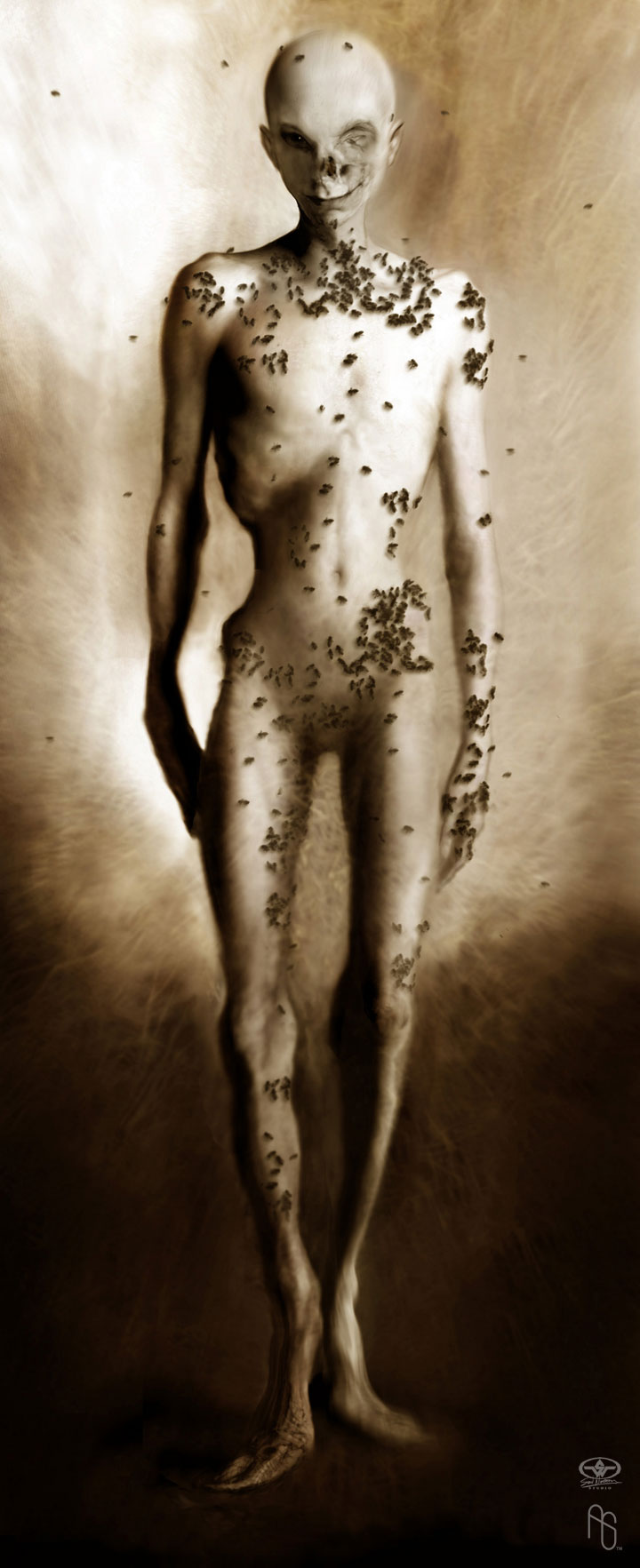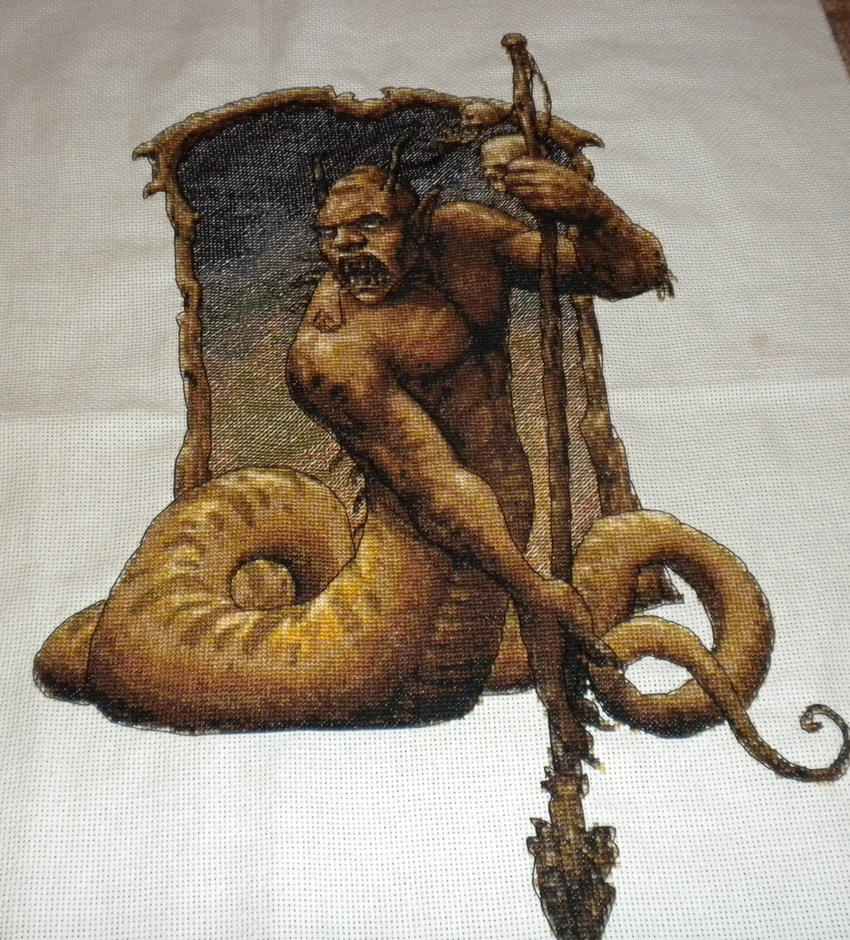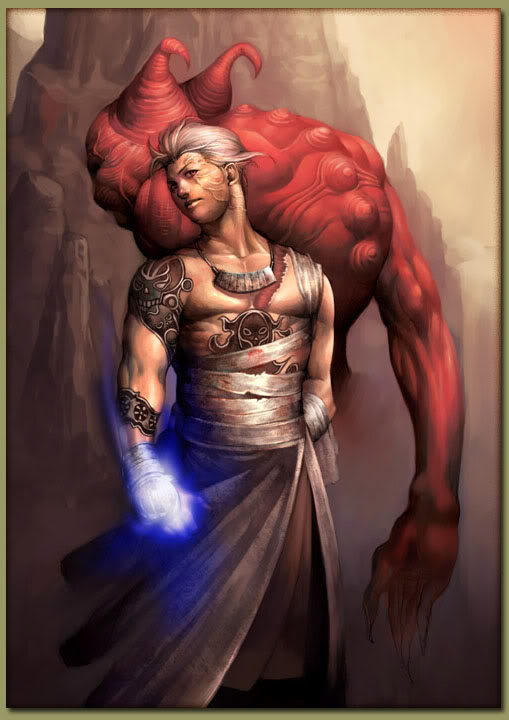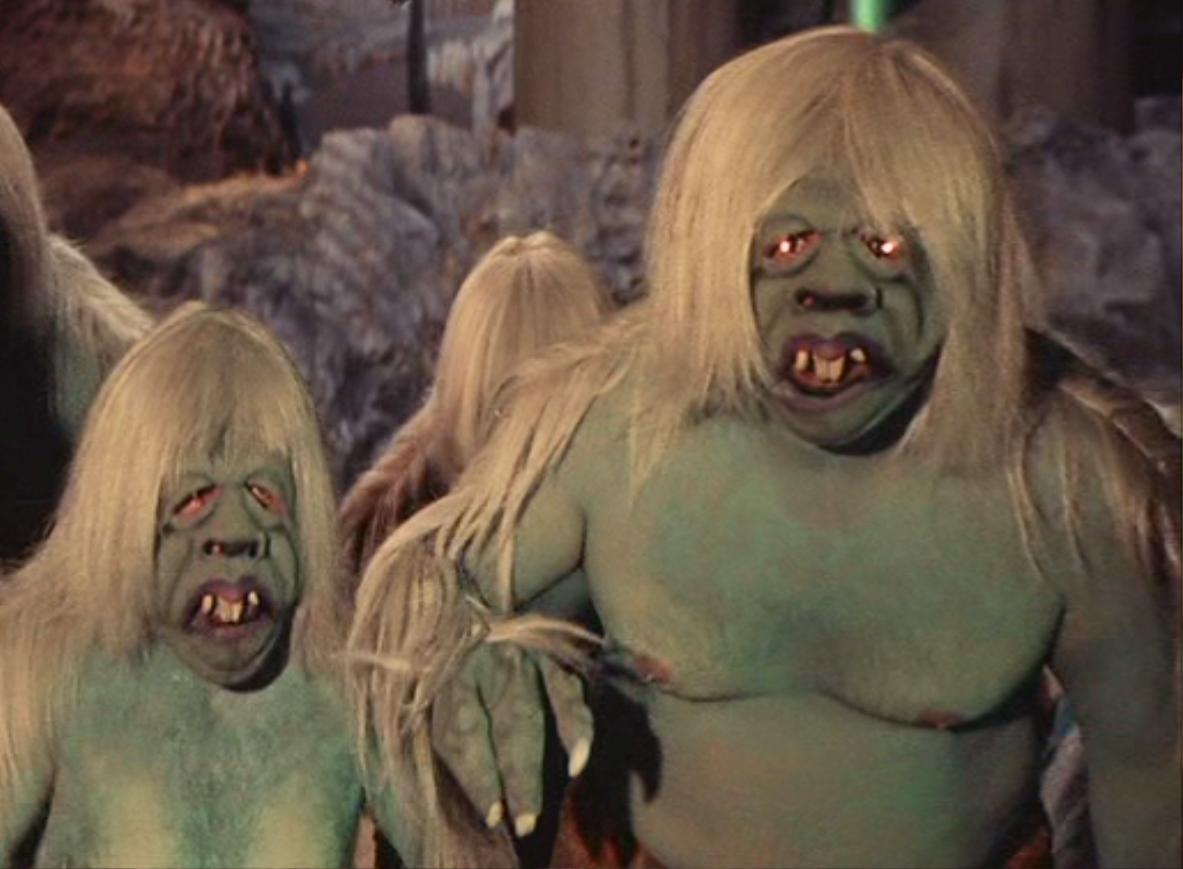This story has me intrigued me. We have a somewhat unreliable narrator (and I call her unreliable because she's isn't every narrator?) and a hero who seems likable. He's intelligent and thoughtful. This story reminds me of Sir Thomas Moore's utopia like we said in class because the setting seems perfect and innocent of a corrupt, restrictive society. However, I'm not sure if I'm fond of how the natives were portrayed as innocent and ignorant of the world. Maybe it's just the narrator. I know she's doing the best she can but her voice is so condescending that it becomes annoying. Yet annoying as it might be I have to give her a little leeway. -My initial response to Oroonoko
3 out 2
Saturday, November 30, 2013
Friday, November 29, 2013
On Oroonoko's Looks
While I'll be going into just how messed up and twisted the ending to this story is in another blog post (because, believe you me, it deserves it), I thought I might backtrack a bit and touch upon the curious matter that is how Oroonoko's (excuse me, 'Caesar's') appearance is presented to us, the audience. It's probably the one thing outside of the ending that I find really fascinating and unique about this story.
It''s hard for me to keep in mind Behn's audience when reading "Oroonoko". At the time, they knew little to nothing about even the bare concept of slavery, let alone how to feel about people who just so happened to carry a different skin tone from their own. I can only imagine how conflicted many of them probably were when reading this story in particular, especially with the way in which the protagonist himself is illustrated.
Make no mistake, Behn clearly wants her readers to look at this seemingly 'alien' and utopian world as something completely different from their own, yet she never seems to go so far deep that she turns them away. Oroonoko himself is described as having traces of European or 'Roman' descent, and in such a way that he ends up being elevated over the rest of his people as the sympathetic protagonist.
I can only imagine that Behn's readers might have clung to these few physical similarities that Oroonoko has to themselves, for the sole reason that those skin-deep features automatically make him easier to warm up to. Yes, it's a shallow way to judge a character, but it seems like appearances were a lot more important in judging a person then than they are now.
It''s hard for me to keep in mind Behn's audience when reading "Oroonoko". At the time, they knew little to nothing about even the bare concept of slavery, let alone how to feel about people who just so happened to carry a different skin tone from their own. I can only imagine how conflicted many of them probably were when reading this story in particular, especially with the way in which the protagonist himself is illustrated.
Make no mistake, Behn clearly wants her readers to look at this seemingly 'alien' and utopian world as something completely different from their own, yet she never seems to go so far deep that she turns them away. Oroonoko himself is described as having traces of European or 'Roman' descent, and in such a way that he ends up being elevated over the rest of his people as the sympathetic protagonist.
I can only imagine that Behn's readers might have clung to these few physical similarities that Oroonoko has to themselves, for the sole reason that those skin-deep features automatically make him easier to warm up to. Yes, it's a shallow way to judge a character, but it seems like appearances were a lot more important in judging a person then than they are now.
Wednesday, November 27, 2013
Gray and Gray
Often in class discussions, big abstract concepts get brought up, with the point seeming to be to remind us that, no, things are not quite so simple. There is no absolute good and there is no absolute evil; the world is not kind enough to us to be so easy. This perhaps is discussed more when looking at Magic and Mysticism than in this particular class, but it is worth considering here as well.
Having just finished with our examination of Paradise Lost, we were presented with a sympathetic view of Satan, who is shown to have qualities that could very well be seen as positive. He is ambitious, charismatic, cunning, and a skilled leader. Still however, he is Satan.
In the story of Oroonoko, we are presented with an educated, charming and skilled warrior, who is described even in the title as “royal”; connecting deed to European ideas of nobility rather than blood. Yet, Oroonoko plays an integral part in continuing tragedy of the global slave trade. Though he is presented as a positive character, it is his actions that condemn hundreds, if not thousands to bondage. He leads his people to battle, and then leads others in chains.
Oroonoko reminds us that “Good and Evil” is not the case with the real world. By presenting what is supposedly a true story, we see all sides of an awful situation, and are given a chance to examine it from all sides. Can you think of any particularly good examples of "Gray and Gray Morality" in literature or in real life? What did you think about the situation presented by this sort of conflict? Tell us in the comments! --- 3 of 5
Tuesday, November 26, 2013
The Demon’s Arguments Part IV
Ahhhh Beelzebub, the second best demon in hell. Satan’s
right-hand man. The mouth piece of hell. A wondrous foul beast, who is also a
pretty cool-cat. Milton describes Beelzebub as follows:
“Which when Beelzebub perceived—than whom,
Satan except, none higher sat—with grave
Aspect he rose, and in his rising seemed
A pillar of state. Deep on his front engraven
Deliberation sat, and public care;
And princely counsel in his face yet shone,
Majestic, though in ruin. Sage he stood
With Atlantean shoulders, fit to bear
The weight of mightiest monarchies; his look
Drew audience and attention still as night
Or summer's noontide air”
Now, I don’t know about you but I was very excited to see
what the internet was going to find for me—image-wise—regarding Beelzebub. I
hopped for AWESOME, because that’s basically how Milton wants us the readers to
visualize him—a big hulk of monstrous, handsome, conniving, perfection.


Needless to say I was super disappointed in the available
artwork. Apparently there is an anime Beelzebub, but he doesn’t seem very
impressive either. I wonder why he isn’t depicted in art more? I even narrowed
my searches and even looked specifically for Paradise Lost artwork…nothing impressive. For the other demons I
was able to find some pretty interesting artwork, but not for Satan’s
right-hand man, it seems odd... Especially since according to Milton, Beelzebub
was the mouth piece of Satan. I would think he would be seen more, rousing the
other demons to do Satan’s bidding, but somehow making it seem like it was
their idea the whole time. The images I was able to find just left me wanting…
The frustrations of Oroonoko
I don’t know why but I find this reading for Oroonoko, by Aphra Behn to be one of the hardest one’s yet. A month
or two ago I would have been so happy to read a bit more prose and now I’m just
like holy moly there is so much text on one page. Aside from the length though
it’s still a hard read for me and I think it is because this story is further
away from religion and closer to the nasty nature of human beings. Slavery is a
topic that I both hate and love to learn about as a history major. I get
extremely passionate about it so it may be clouding my judgment somewhat while I
read Oroonoko. I’ll have to work on that.
I
have been trying to think about what Dr. Mitchell-Buck said about if there was
a hierarchy…who would be the nicest or morally good characters and I’m just
like um none of them. So far though, into the first reading, I would say that
Imoinda might be the nicest one. She seems the most innocent and obviously the
most beautiful since everyone wants her. “On the other side, the old king, who
had many wives and many concubines, wanted not court flatterers to insinuate in
his heart a thousand tender thoughts for this young beauty, and who represented
her to his fancy as the most charming…” (2189). They all seem pretty awful
though, especially their views on slavery, Oroonoko included. The main
character himself sold slaves to people and then he later ends up becoming a slave
as well. Oh the irony.
Monday, November 25, 2013
Milton vs. Dante's Satan
By far, what has interested most in all of "Paradise Lost" has been Milton's interpretation of Satan as a sympathetic character. Considering that the poem was written in the time that it was, it seems like it would have been a controversial outlook, because up until then I can only assume that the general public was more used to traditional illustrations of him through other pieces of either epic poetry or biblical stories passed down through sermon. The most obvious one that comes to mind is the equally famous “Divine Comedy”
Written 112 years prior, Dante’s epic piece is considered by many to be the quintessential illustration of Hell’s anatomy (as well as Purgatory and Heaven). In the last circle of his intricate geography of it, the character of Satan is portrayed more as an abstract caricature than an actual character.
In Dante’s poem, Satan is a mindless, bestial-like creature locked in an icy lake. He can’t even speak with any of his three mouths, only because he’s too busy dumbly chewing on the three most notorious of traitors. Even then, it’s also implied that he’s too stupid to even speak a word.
Milton’s portrayal of Satan is a complete 180 from this, and I can’t help but wonder how a general public might have reacted to being ‘tricked’ into having, quite literally, sympathy for the devil himself. Up until then, they had been given these similar ‘embodiment of all evil’ sorts of interpretations, especially from Dante’s work so many years prior.
From poem to prose
Paradise Lost is an amazing poem that requires much analysis and trying to figure out what the subject of the sentence is can be tough, but the close reading we did in class really helped me grasp the meaning of it as a whole. It would be neat if we could continue reading it, but alas there is not enough time in the year. Now as we are reading Oroonoko, it seems easier to read than especially the poem of Paradise Lost.
Taking a step back from the prose though, I have to think that it cannot be as easy as it seems. There seem to be a bunch of hidden meanings that one has to keep an eye open for, and I cannot wait to see how we analyze this in class.
However interesting prose can be, I sometimes find more enjoyment in the analysis of poetry because there can be so much more depth within one line of poetry than sometimes one book itself. Poetry is rhythmic and beautiful and although harder to grasp, it is easier to memorize when rhyme scheme comes into play. I love poetry, but I also love reading prose as well.
As a general consensus and as a poet on the side, I want to ask the class your opinion on which is easier to read: prose or poetry?
And... does that opinion differ from what you enjoy reading more: prose or poetry?

Reference: http://www.poetrysansonions.com/2012/11/a-post-title-without-prose.html
Blog Challenge: 3 of 5 :)
Taking a step back from the prose though, I have to think that it cannot be as easy as it seems. There seem to be a bunch of hidden meanings that one has to keep an eye open for, and I cannot wait to see how we analyze this in class.
However interesting prose can be, I sometimes find more enjoyment in the analysis of poetry because there can be so much more depth within one line of poetry than sometimes one book itself. Poetry is rhythmic and beautiful and although harder to grasp, it is easier to memorize when rhyme scheme comes into play. I love poetry, but I also love reading prose as well.
As a general consensus and as a poet on the side, I want to ask the class your opinion on which is easier to read: prose or poetry?
And... does that opinion differ from what you enjoy reading more: prose or poetry?

Reference: http://www.poetrysansonions.com/2012/11/a-post-title-without-prose.html
Blog Challenge: 3 of 5 :)
Sunday, November 24, 2013
The Demons’ Arguments Part III
Now, Mammon is perhaps the demon I most looked forward to
reading about. I know of Mammon from the comic-con world as Satan’s son. He was
supposed to be the Devil’s response to God and Jesus. The Devil felt that if
God was to have a chosen Son, so would he. Basically the response “anything you
can do, I can do better” which is pretty fitting to what we’ve read of Satan,
in Milton’s world at least.
So reading Mammon in Paradise Lost was actually a bit of a
disappointment. I wanted Satan’s son, instead I get a demon content with the
realms of hell. Belial and Mammon seem to be on the same page as each other,
both content to sit around and not do much…well at least Mammon wants to make
hell a little more “homey.”
Mammon is the deity of greed.
In Book One of Paradise
Lost, Mammon is described as:
“Mammon, the least erected Spirit that fell
From Heaven; for even in Heaven his looks and thoughts
Were always downward bent, admiring more
The riches of heaven's pavement, trodden gold,
Than aught divine or holy else enjoyed
In vision beatific. By him first
Men also, and by his suggestion taught,
Ransacked the centre, and with impious hands
Rifled the bowels of their mother Earth
For treasures better hid.”
This version is found online at http://classiclit.about.com/library/bl-etexts/jmilton/bl-jmilton_plost_1.htm
I of course wanted to find visual representations of this
demon. The Mammon I expected was

The Mammon images that better fit Milton’s ideal are


These images fit what Milton describes because, as he
states, Mammon was evil from the get-go. His view was already downcast. He
likes hell because he never liked heaven to begin with. I still would’ve liked
the Constantine comic version though…
The Demon’s Arguments Part II
The second demon to speak is Belial, which in Hebrew means
worthless. He seems to be the deadly sin Sloth personified, or rather
demonified. Milton describes Belial as:
“On th' other side up rose
Belial, in act more graceful and humane.
A fairer person lost not Heaven; he seemed
For dignity composed, and high exploit.
But all was false and hollow; though his tongue
Dropped manna, and could make the worse appear
The better reason, to perplex and dash
Maturest counsels: for his thoughts were low—
To vice industrious, but to nobler deeds
Timorous and slothful. Yet he pleased the ear,
And with persuasive accent”
Again, this version of Paradise
Lost comes from the website http://classiclit.about.com/library/bl-etexts/jmilton/bl-jmilton_plost_2.htm
(It just makes it easier to cut and paste instead of typing it all out manually).
So, Milton describes Belial as graceful, humane, fair,
dignified, false and hollow, noble, slothful, and persuasive. As another classmate
had posted, the demon of college students…I might even go so far to add that
Belial is the patron demon on English majors specifically.
Two images I found of Belial are


These depictions of Belial are fitting; he actually looks
pretty dang cool if you ask me.
He looks and name (with the Hebrew meaning) are a perfect
fit for his argument, which is basically like “Hey guys, we should totally just
wait it out here. We shouldn’t listen to Moloch, we’ll just lose again. The
best course of action is no action at all. Maybe if we wait around not doing
anything long enough God will forgive us maybe…”
Overall, he is a pretty worthless
demon.
O yeah, I forgot to add in my last post about how Moloch
reminded me of the movie The Time Machine (no I haven’t yet read the book by H.G.
Wells). I’m referring to the movie from the 1960s, because I'm cool like that...or something like that...
In the movie the main character travels far into the future
where the race of humans are preyed upon and eaten by nefarious under-dwellers
called the “Morlocks,” coincidence—I think not.

The Demons’ Arguments Part I
I loved the demons’ and their arguments regarding what their
next move should be. I know we talked about them in groups, but I wanted to
talk a little more about them.
I was fascinated by Moloch’s vengeful aggression. But it makes
sense. The demon himself makes sense and I can see why Milton would choose him
to be one of the voices for the war argument. Moloch or Molech means “king” in
Hebrew. Moloch was one of the Caananite gods (from the Bible). The followers of
Moloch needed to sacrifice their children by throwing them into fire.
“next him Moloch, sceptred king,
Stood up—the strongest and the fiercest Spirit
That fought in Heaven, now fiercer by despair.
His trust was with th' Eternal to be deemed
Equal in strength, and rather than be less
Cared not to be at all; with that care lost
Went all his fear: of God, or Hell, or worse,
He recked not”
This version comes from the website: http://classiclit.about.com/library/bl-etexts/jmilton/bl-jmilton_plost_2.htm

The description Milton provides of this demon is fitting to
the images I was able to find online. He is “bull-headed” both literally and
figuratively. He also appears strong and kingly. His characteristics fit his argument
which is to attack Heaven again, because he feels he and the other demons have
nothing to lose. They could lose hell and lose the eternal pain they feel or
they could gain heaven. To him the only feasible option left for them is to
fight. Even though he’s a pretty awful demon, you kind of have to respect his
tenacity.
SO MUCH IMAGERY
What struck me most while reading Paradise Lost was the imagery. It's everywhere! And considering that John Milton went blind and was dictating his writing to scribes and managed to write this beautiful, complex, and vivid work of art is crazy to me. I can’t even describe my own head of hair without sounding awful and yet Milton is describing amazing things that he’s never even seen when he wasn’t blind! (At least I’m assuming he’s never seen hell…)
I think he definitely appreciated the beauty in life, even when he couldn’t see it, and even though he was a huge grump. I think that’s what I like about Milton the most. I love the idea of him being so in awe of our world and finding just the right words to describe it.
Subscribe to:
Comments (Atom)
